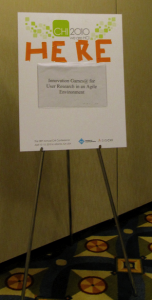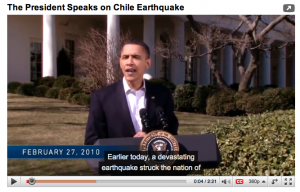
"Prototyping with Junk" at UC Berkeley
Award for Junk
Did you catch the New York Times word of the year (WOTY) for 2010? It’s junk! The editors of the “On Language” column chose this word as representative of the zeitgeist of the past year. The honor acknowledges the basic meaning of rubbish or trash, debris or detritus, as well as extended meanings: From junk bonds (devalued securities) to junk food (nutritionally empty), to junk shot (stuffing debris and mud into BP’s leaking gusher in the Gulf). Their award called out one euphemistic sense, the male genitalia. The TSA started full body pat-downs in 2010, as an alternative to scanning, and air travelers gave warning, “Don’t touch my junk.”
Next month I’ll be hosting the activity “Prototyping with Junk” at Interaction Design 2011 (IxD11) in Boulder, Colorado. As I’ve previously written, I occasionally get pushback from people who feel junk is not appropriate language for professional settings. Or, perhaps their reaction is that junk — the actual stuff — is not for the workplace. Now I can respond to those objections with the citation of WOTY2010. I’m hip!
JunkFest (2007)
And I’m in good company: Bernie DeKoven, author of Junkyard Games, and funsmith extraordinaire, recently shared a video from 2007 celebrating Junkyard Sports. Here’s an news report from JunkFest in Redondo Beach [warning: narration lacks captions]
Kinetic sculpture with junk
Another wonderful example of how using apparent junk (PVC pipes plus a bunch empty plastic bottles, and other stuff) can turn into something magical: see how kinetic sculptor Theo Jansen simulates animals walking, powered by the wind near the sea.
[warning: narration lacks captions]
Read more at Talking Science: Dance of the Strandbeests, the BBC article about this project.
Jansen’s example shows how prototypes evolve into working “products” or art, depending on your perspective. His process of successive refinements suggest agility: at each juncture, he stops and tests his creatures, from human-propulsion of walking machines to wind-propulsion (which simulates self-propulsion), and all from vernacular materials with clever engineering.
Learning with junk
We used Prototyping with Junk at ACM CHI2004 (in Vienna, Austria), when we challenged the participants in the pre-conference design collaboration to create a product for elders. As I’ve written for interactions magazine special issue on prototyping, this is an opportunity for creativity and fun in a social context. And, it’s yet-another communication tool for your collaborative design kit.
More recently, students at UC Berkeley’s iSchool engaged in Prototyping with Junk as one among many prototyping techniques they experimented with this past fall. You can see still images and a few short movies. Notice all those smiles!
Eager to meet the group in Boulder. I’ll bring one of the several design challenges I’m currently mulling over, …and plenty of junk.

Poster announcing Course 27 at CHI2010
What can you do in 90 minutes to introduce a professional audience to the set of practices which are Innovation Games®? Quite a bit!  But not all of what we had planned.
The course announcement
Here’s what people saw on the web when they considered whether to enroll in this course “Innovation Games® for User Research in an Agile Environment”, which competed against about 10 other sessions in the same time slot.
This course describes a set of qualitative research methods that will be attractive to user researchers, customer satisfaction specialists, Chief Happiness Officers, marketing professionals, among others. People who participate on Agile teams and those who are considering making a change to Agile practices will enjoy learning new techniques that fit into an Agile framework. Designers, engineers, and others with limited research background are welcome to join in the fun. (more…)
Tags: chi, chi2010, conference, course, design games, fun, Innovation Games®, observers, training, User Experience, ux

Tuesday, March 9, we got the next update on YouTube’s automated captioning efforts. I heard it on NPR’s “All Things Considered” afternoon program, in which Robert Siegel interviewed Ken Harrenstien of Google with a (female) interpreter providing voice for the Google engineer.
Audio and transcript are available at http://www.npr.org/templates/story/story.php?storyId=124501330.
Harrenstien acknowledges that automated captioning today stumbles on proper names, including trademarks and product names: Â ”YouTube” that comes out “You, too!” And automated captioning has difficulty with videos that have music or other sounds in the background. But, he characterizes himself as a technology-optimist, anticipating that in 10 years things will be much improved.
Benefits of captioning
Like “curb cuts” which have become the symbol indicating that solutions for disabled people (here, those in wheelchairs) resolve needs for others (strollers, roll-aboard luggage, shopping carts), captions have benefits that extend beyond hearing impairment.
- Deaf and hearing impaired people can enjoy the huge inventory of videos on YouTube. (The still frame that opens this post is from an announcement by President Obama in response to the Chilean earthquake. Making emergency and other time-sensitive news available to those who cannot hear meets the requirements of laws and regulations in the US. And more importantly, it meets the moral or ethical standards we expect from a civilized society where we include everyone in the polity.)
- If you’re in a noisy environment or located close to others who will be bothered by the audio, you can figure out what the video is saying even without benefit of headphones
- Small companies can afford to provide captions on their webcasts, often the heart of learning about new products
- Non-native speakers of English have a much better chance of understanding speech at ordinary (rapid) rates with the assist of captions
- Captions provide input to machine translation services, so that there soon will be captions in other languages besides English as well; as automated speech-to-text technology improves, we’re going to see other input languages as well
- Captions provide much better input to (current) search technology than speech does, so there’s hope of finding segments of videos that might not appear in written form
Professional captioners need not despair
I read the YouTube blog post of March 4 and the comments following it, and recalled the announcement of the limited trial with selected partners last November.  James expresses concern in his comment about the recent YouTube announcement that people, like him, who earn their living as captioners for post-production houses will lose their jobs as a result of the automated captioning.  My response seconds HowCheap’s comment that professional captioners will continue to find work both as editors of the automated speech-to-text and for organizations prefer doing their own captioning. Organizations that produce professional quality video typically start from a written script, adjust for the few changes that happen in the spoken version, and then set the timing of the text with the video.
The huge number of videos on YouTube are uploaded by individuals or by small organizations who may not be aware of the benefits from captioning, and likely don’t know about the tools available. Â According to YouTube’s fact sheet: “Every minute 20 hours of video is uploaded to YouTube.” That’s a volume that is beyond the capacity of professional captioners and the organizations that employ them.
A proposal for improving the quality of captions
How shall we improve the quality of automatically produced captions?
I’d like to see interpreter training programs (ITPs) make editing automated captions a course assignment, a program requirement, or a component of an internship. Engagement with spoken language, not one’s own, is a challenge.  People phrase things in ways you don’t; they use unfamiliar vocabulary and proper names (streets, towns, people, products) that I need to look up.  Both ITPs for training sign language interpreters and those for people learning to interpret between 2 spoken languages may allow entry to students whose skills in listening, writing or spelling may be lacking.  How many caption-editing assignments are enough? Shall we also coordinate quality checks by others in the same or a different program?  Such assignments will guide students toward greater appreciation for the challenges of speech in online settings, with a task that provides an authentic service.
VRS and VRI
In the case of ITPs for sign language interpreters, the improved listening to online speech is great preparation for work settings such as VRS and VRI. Â Video Relay Service (VRS) in the US is regulated by the FCC: deaf signers who cannot use the telephone (because their speech is not intelligible and they cannot hear well enough to understand speech over the phone) make use of intermediaries (interpreters) to communicate with hearing non-signers. (Think of simple tasks such as calling the school to notify them that your child will be absent; scheduling a haircut; ordering a pizza for delivery, not to mention more complex transactions involving prescriptions, real estate contract negotiation, billing disputes.) Â Video Remote Interpreting (where the deaf and hearing parties are physically together, with the interpreter remote from them) is a service with similar requirements for the interpreter (listening to speech over a phone or data line, and rendering accurate translations in real time).
Broad multi-disciplinary open source content quality
Programs training instructors in English as a Second Language (ESL) could also participate. Â Students in speech therapy and audiology would benefit from both the direct engagement with spoken language “in the wild” and with future colleagues in other disciplines. There are advantages to engaging a variety of people who are studying for professions that emphasize expertise in spoken and written English.
Looks like an open source content development effort to me. Yes, it will require a little bit of coordination, but not terrific overhead. How about it, ITP program directors?
Tags: automatic, captions, ESL, Google, interpreter, ITP, speech-to-text, training, VRI, VRS, YouTube


